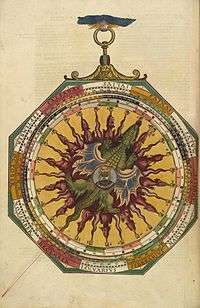Volvelle



A volvelle or wheel chart is a type of slide chart, a paper construction with rotating parts. It is considered an early example of a paper analog computer.[1] Volvelles have been produced to accommodate organization and calculation in many diverse subjects. Early examples of volvelles are found in the pages of astronomy books. They can be traced back to "certain Arabic treatises on humoral medicine"[2] and to the Persian astronomer, Abu Rayhan Biruni (c. 1000), who made important contributions to the development of the volvelle.[3]
In the twentieth century, the volvelle had many diverse uses. In Reinventing the Wheel, author Jessica Helfand introduces twentieth-century volvelles with this:
| “ | The twentieth century saw a robust growth in the design, manufacture, and production of a new generation of independent, free-standing volvelles. Categorically, they not only represent an unusually eclectic set of uses, but demonstrate, too, a remarkable range of stylistic, compositional, mechanical, informational, and kinetic conceits. There are volvelles that arrange their data peripherally, centrifugally, and radially; volvelles that use multiple concentric circles with pointers; and volvelles that benefit from the generous use of the die-cut, a particular technological hallmark of modern printing manufacture. Twentieth-century volvelles—often referred to as wheel charts—offer everything from inventory control to color calibration, mileage metering to verb conjugation. They anticipate animal breeding cycles and calculate radiation exposure, measure chocolate consumption and quantify bridge tips, chart bird calls, convert metrics, and calculate taxes. There are fortune-telling wheels and semaphore-charting wheels; emergency first-aid wheels and electronic fix-it wheels; playful wheels that test phonetics and prophylactic wheels that prevent pregnancy.[4] | ” |
The rock band Led Zeppelin employed a volvelle in the sleeve design for the album Led Zeppelin III (1970).
Two games from the game company Infocom included volvelles inside their package as "feelies": Sorcerer (1983) and A Mind Forever Voyaging (1985). Both volvelles served to impede copying of the games, because they contained information needed to play the game.
Venus volvelle
The most ancient example of a simple volvelle was the pentagram from Hammurabi's day that has become the symbol of witchcraft. It is actually the path of Venus in 8 years and it does rotate in full circle in a span of 1199 or 1215 years. (1200×365 days or 5×243 years) But owing to Venus averaging 583.92 days, the 750 synodic orbits in 1200 years (750×584 days) has a correction of 60 days less, or 30 days less in 600 years. This is to be noted when the ancient Great Year of 600 years is said to be oriental, and the oriental calendar includes a 60-day cycle. However, the 600-year calendar (cycle) is assumed to be Jupiter by equating it with 12-year calendar.
Notes
- ↑ Nick Kanas. "VOLVELLES! Early Paper Astronomical Computers". Mercury (March–April 2005). Retrieved 2009-10-13.
- ↑ David Kahn (March 1980). "On the Origin of Polyalphabetic Substitution". Isis. University of Chicago Press. 71 (1): 122–127 [126]. JSTOR 230316. doi:10.1086/352410.
- ↑ Bryan S. Turner (March 1987). "State, Science and Economy in Traditional Societies: Some Problems in Weberian Sociology of Science". British Journal of Sociology. Blackwell Publishing. 38 (1): 1–23 [12]. JSTOR 590576. doi:10.2307/590576.
- ↑ Jessica Helfand (2002). Reinventing the Wheel. Princeton Architectural Press. ISBN 978-1-56898-596-1.
See also
References
- Eye, No. 41, Vol. 11, edited by John L. Walters, Quantum Publishing, Autumn 2001.
- Lindberg, Sten G. "Mobiles in Books: Volvelles, Inserts, Pyramids, Divinations, and Children's Games." The Private Library, 3rd series 2.2 (1979): 49.